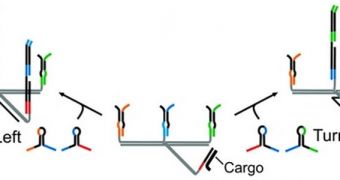Investigators from the University of Oxford, in the United Kingdom, announce the development of a tiny robot made entirely out of DNA strands. Unlike other similar contraptions, the machine can be steered in any direction the researchers see fit.
The innovation may enable the creation of advanced nanoscale devices in the near future. These machines will be able to navigate the insides of the human body with great efficiency, and perform repair operations where they are needed.
One possible application would be for them to perform surgeries that today need advanced procedures to be completed, while at the same time entailing large risks. Of course, other futuristic applications will also be possible with the new technology.
Among all other devices of its class, the new micromachine is the only one of its class to be able to accept instructions from the outside, At the same time, it can also conduct basic operations autonomously, without the need for experts to tell it what to do every step of the way.
The University of Oxford team was coordinated by lead researcher and professor Andrew Turberfield. Details of the innovation appear in the March 9 issue of the esteemed scientific journal Nano Letters.
“Turberfield's group has figured out a beautiful way to automate the movement of a strand of DNA along a track,” explains Brookhaven National Laboratory (BNL) associate scientist William Sherman, who was not a part of the study.
“As we build smaller and smaller parts, we are getting to the point where it is harder to build things that are below a certain scale,” adds California Institute of Technology (Caltech) graduate student Nadine Dabby, also not a part of the work.
She explains that self-assembly has therefore become a holy grail of sorts in the scientific community. Experts are looking for structures that, once mingled together, would form desired objects directly inside the body, LiveScience reports.
“DNA happens to be a molecule that scientists understand a lot about, and it also has a built-in way to control it, or program it, and it is very easy to work with,” the graduate student adds.
“By specifying the sequence of a molecule of DNA we can control what it will bind to or interact with,” Dabby goes on to say. “Information is programmed into the design of the base sequences of the DNA strands,” Turberfield adds.
The UK team plans to continue its investigations into the new robot. This will enable them to improve and expand on the overall design, and also to take this field of research one step further.

 14 DAY TRIAL //
14 DAY TRIAL //